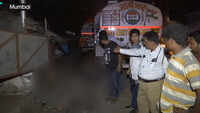
* LIT PROJECTS
1. BROWN REVOLUTION: PAPER FROM COW DUNG
MTech Chemical Engineering student Shreyanshi Gupta found a solution to solve two most-troubling problems — rampant tree felling and cattle menace. She experimented with cow dung to develop handmade paper which replaces paper made of wood. She calls it the ‘Brown Revolution’. The theme revolves around valorization of cow dung. It focuses on the complete usage of cow dung and the making of value added products from it with zero wastage. The process makes the disposal of tonnes of cow dung easier and in a manner that adheres to the environmental norms.
HOW IT WORKS
The work involves separation of lignin — a compound which strengthens trees — and cellulosic constituents from cow dung. These components can be further utilized in producing useful materials like handmade paper and lignin which can be converted into lignin phenol formaldehyde resin or could be sold directly in the open market.
EXPERIMENT
* The cellulosic constituent isolated from cow dung was successfully utilized in making handmade paper at the lab level.
BENEFITS
* Gaushalas across the country can be a source of cow dung
* It will reduce the number of trees felled to make equivalent paper
* End products can be sold in the market with high profit value
* Stray cattle can be kept in a fenced compound and entrepreneurs can utilize their waste to start projects
* A small unit, consuming 500kg of dry cow dung, can generate direct and indirect employment to 10-100 people
*An investment of Rs75 lakh will be required
* There’s a possibility of the theme getting extended by blending cow dung with several kinds of kitchen waste like cabbage leaves, coconut coir etc
2. SAND-LIKE PARTICLE USING FLY-ASH
B. Tech student Sumit Mandal was concerned about the manner in which large-scale sand mining was harming nature. He was also appalled on knowing that a whopping 160 million tonnes of fly-ash is generated from thermal power plants in India. If sand mining posed threat to bridges, river banks and nearby structures, excess amount of fly-ash was a major air and ground pollutant. Finding a solution to these problems, Mandal thought of utilizing flyash aggregates to replace sand in construction. He says there are several ways to utilize fly-ash but the term ‘utilization’ is misleading because a large part of it is dumped at places like ponds.
HOW IT WORKS
A thermo-chemical process for aggregate preparation is required. Fly-ash is utilized for making useful products such as aggregates. The process is not high tech and small ventures can handle it. Feasible and economical, fly-ash aggregates will cost Rs2per kg. The cost can be lowered through mass production.
BENEFITS
PROBLEMS RELATED TO SAND MINING
* Habitat loss, soil erosion near river banks, aquatic life affected, sand mafia posing threats to local administration, diversion of river paths, escalation of sand prices. If the process is implemented then the cost of construction can come down.
PROBLEM RELATED TO ASH DISPOSAL
* Disposal of fly-ash causes land pollution, health issues such as lung diseases to the nearby population. This process can reduce the damage caused to the environment.
3 WATER-RESISTANT TILES FROM PLASTIC WASTE
MTech student Tushar Maske worked on converting plastic waste into useful composite materials. The inept handling of plastic waste was affecting innocent animals on land and in water. ‘My waste is my responsibility,’ he says. So far researchers have worked on plastic waste to develop paver blocks or lay roads. Maske designed and developed tiles from three different materials — poylethylene terephthalate (PET) present in plastic bottles, poly proplene (PP) in food containers and high density polythene (HDPE) in FMCG containers.
HOW IT WORKS
Maske selected one plastic from these three products and mixed them with plastic and sand using thermochemical treatment. Agro waste and kitchen waste materials, too, were mixed to make the tiles. Cigarette buds, saw dust and ash can be used. These tiles can be used in homes, swimming pools or check dams as they do not break but can be drilled in, grinded or cut to suit the user.
BENEFITS
* Hazards of the ever-rising plastic waste, land pollution, fire break-outs, water pollution at dumpyards, choking of drainage lines, seas, oceans, fish deaths will be prevented
* It’s a low-cost initiative as it requires a total investment of Rs25 to 30 lakh. The profit is Rs13 per square foot. This makes the income R60,000 per month.
* A one rupee hike in the cost of the tile will give an additional income of Rs37000
SOCIAL IMPACT
* Employment generation with waste turning into wealth
* Nagpur alone generates 46 tonnes of plastic wastes per day. Hence, 46 units can be set up in the city
GUIDE SPEAK
These projects are basically indicative and based on the theme of wealth from waste. Though at the preliminary stage, they have a huge scope and utility from several possible dimensions. They need to be taken up on a priority basis and rigorous field tests are a must prior to any kind of commercialization. Tushar's project shows utilization of plastic as well of agro and kitchen waste. Shreyanshi's theme is about the possible utilization of cow dung in a better manner and with value addition. Sumit's theme is again based on wealth from waste.
Shekhar Pandharipande | associate professor, LIT department of chemical engineering
SB Institute of Technology, Mangement and Research
Projects
1.
ECO-FRIENDLY BRICKS
This project by a group of final-year mechanical engineering students from SB Jain look a merger of that from LIT’s Tushar Maske and Sumit Mandal. While Mandal looked at fly-ash utilization, Maske worked on plastic waste disposal. These students have put both plastic waste and fly ash to their advantage. They developed ecological bricks to effectively utilize the two sources of pollution. They said while the non-biodegradable substance is a great threat for sustainment of ecological balance, fly ash from thermal power plants in India are major air pollutants.
HOW IT WORKS
In their bid to solve the ecological crisis, they attempted to reduce the disposal problem of plastic waste and fly ash by using plastic extruder machine to melt the plastic and then mixing it with other ingredients of the fly ash brick. They added the plastic in a plastic hopper which is melted with the help of a heater. Then, this molten plastic is mixed with quarry dust, fly ash and cement. This mixture of all the constituents is fed to the press feed machine to get the bricks.
BENEFITS
In addition to those already mentioned in LIT projects, this model aims to reduce the soil getting wasted during the manufacturing of burned bricks by producing a brick which is environmentally friendly and also economical.
TEAM
Students: Saurabh Lanjewar, Sanket Fulzele, Abhishek Motghare, Gokul Bharbat, Bhushan Bhalerao, Pranay Arghode, Ashwin Noroliya
Guide: HS Bhatkulkar
2 ORGANIC DRUM COMPOSTER
This group from the same branch found answer for farmers and households waste. They developed an organic drum composter which has a wide range of application at restaurants, households, hotels, apartments building, schools, communities, offices, temples and cafeterias depending on the capacity of the machine. The machine can run on electricity as well as solar energy. By using it, farmers can become self-dependent for their everlasting requirement of fertilizers. Basically, it is used for kitchen waste but if a bigger machine is built it will help process municipal waste too.
HOW IT WORKS
Due to the small but robust design, it provides safety to the operator as well as to others working around it. By removing the motor arrangement, the drum can be rotated by hand so it saves a lot of power.
BENEFITS
* People will learn about food waste and cut their wastages
* Societies and government offices, schools and colleges can own their own composing machine to process waste at source
* Less strain on government resources, disposal cost and landfills
TEAM
Guides: Pankaj Jaiswal and Ajay A. Joshi
Students: Jay S. Takalkhede, Aniket A. Kherde, Rajat R. Barde, Saurabh V. Shrikhnde, Amol A. Sonwane
3 SOUND WAVE EXTINGUISHER
This group came up with an out of the box method to solve one of the biggest hazards of urban life. It used sound waves as a potential alternative in putting out flames. This Instant Fire Suppression device specifically uses unconventional method of tackling fires in enclosed spaces such as kitchens, hospitals and shopping malls, The method maybe extended to be used in enclosed spaces of industries and railways where fires are obviously devastating and incredibly difficult to control.
HOW IT WORKS
The acoustic pressure and air velocity produced from a speaker is the main theory used to explain how sound waves put off flames. It consists of a subwoofer, tone generator, amplifier, switched-mode power supply (SMPS) and a convergent nozzle. At one of the ends of the nozzle, a subwoofer is attached to generate low frequency sound waves and the other end is free. The converging nozzle increases the velocity of sound waves due to which they strike over the flames with high impact. This causes disturbance in the air and fuel mixture and separates oxygen from the burning area and the fire is extinguished to a significant extent. The average time for extinguishing liquid or gas based fire is four seconds.
BENEFITS
* Mega kitchens are a place where accidental cases of oil-based fire are high
* In fires in electrical panel circuit, water is not possible, thus using sound waves to extinguish such a fire is convenient
* Can substitute chemical fire extinguishers as sound waves based fire extinguishers leave no residue and it is non-toxic to the person and the environment
* Could be used in a variety of situations like server rooms packed with computers
TEAM
Students: Aditya Walde, Aman Mandpe, Amit Gajbhiye, Amit Ramteke, Sanket Agashe, Shubhashish Thakur and Tabrez Sheikh
Guide: Jitendra Badkas
Mentor speak
We are proud of our students. The institute and its faculty have always encouraged and supported all their endeavours in grooming scientific temper. We don’t just want graduates to pass out from SB Jain, we aim to deliver innovators to society and the country
Sanjeev Agrawal | CEO, SB Jain Institute of Technology, Management and Research
1. BROWN REVOLUTION: PAPER FROM COW DUNG
MTech Chemical Engineering student Shreyanshi Gupta found a solution to solve two most-troubling problems — rampant tree felling and cattle menace. She experimented with cow dung to develop handmade paper which replaces paper made of wood. She calls it the ‘Brown Revolution’. The theme revolves around valorization of cow dung. It focuses on the complete usage of cow dung and the making of value added products from it with zero wastage. The process makes the disposal of tonnes of cow dung easier and in a manner that adheres to the environmental norms.
HOW IT WORKS
The work involves separation of lignin — a compound which strengthens trees — and cellulosic constituents from cow dung. These components can be further utilized in producing useful materials like handmade paper and lignin which can be converted into lignin phenol formaldehyde resin or could be sold directly in the open market.
EXPERIMENT
* The cellulosic constituent isolated from cow dung was successfully utilized in making handmade paper at the lab level.
BENEFITS
* Gaushalas across the country can be a source of cow dung
* It will reduce the number of trees felled to make equivalent paper
* End products can be sold in the market with high profit value
* Stray cattle can be kept in a fenced compound and entrepreneurs can utilize their waste to start projects
* A small unit, consuming 500kg of dry cow dung, can generate direct and indirect employment to 10-100 people
*An investment of Rs75 lakh will be required
* There’s a possibility of the theme getting extended by blending cow dung with several kinds of kitchen waste like cabbage leaves, coconut coir etc
2. SAND-LIKE PARTICLE USING FLY-ASH
B. Tech student Sumit Mandal was concerned about the manner in which large-scale sand mining was harming nature. He was also appalled on knowing that a whopping 160 million tonnes of fly-ash is generated from thermal power plants in India. If sand mining posed threat to bridges, river banks and nearby structures, excess amount of fly-ash was a major air and ground pollutant. Finding a solution to these problems, Mandal thought of utilizing flyash aggregates to replace sand in construction. He says there are several ways to utilize fly-ash but the term ‘utilization’ is misleading because a large part of it is dumped at places like ponds.
HOW IT WORKS
A thermo-chemical process for aggregate preparation is required. Fly-ash is utilized for making useful products such as aggregates. The process is not high tech and small ventures can handle it. Feasible and economical, fly-ash aggregates will cost Rs2per kg. The cost can be lowered through mass production.
BENEFITS
PROBLEMS RELATED TO SAND MINING
* Habitat loss, soil erosion near river banks, aquatic life affected, sand mafia posing threats to local administration, diversion of river paths, escalation of sand prices. If the process is implemented then the cost of construction can come down.
PROBLEM RELATED TO ASH DISPOSAL
* Disposal of fly-ash causes land pollution, health issues such as lung diseases to the nearby population. This process can reduce the damage caused to the environment.
3 WATER-RESISTANT TILES FROM PLASTIC WASTE
MTech student Tushar Maske worked on converting plastic waste into useful composite materials. The inept handling of plastic waste was affecting innocent animals on land and in water. ‘My waste is my responsibility,’ he says. So far researchers have worked on plastic waste to develop paver blocks or lay roads. Maske designed and developed tiles from three different materials — poylethylene terephthalate (PET) present in plastic bottles, poly proplene (PP) in food containers and high density polythene (HDPE) in FMCG containers.
HOW IT WORKS
Maske selected one plastic from these three products and mixed them with plastic and sand using thermochemical treatment. Agro waste and kitchen waste materials, too, were mixed to make the tiles. Cigarette buds, saw dust and ash can be used. These tiles can be used in homes, swimming pools or check dams as they do not break but can be drilled in, grinded or cut to suit the user.
BENEFITS
* Hazards of the ever-rising plastic waste, land pollution, fire break-outs, water pollution at dumpyards, choking of drainage lines, seas, oceans, fish deaths will be prevented
* It’s a low-cost initiative as it requires a total investment of Rs25 to 30 lakh. The profit is Rs13 per square foot. This makes the income R60,000 per month.
* A one rupee hike in the cost of the tile will give an additional income of Rs37000
SOCIAL IMPACT
* Employment generation with waste turning into wealth
* Nagpur alone generates 46 tonnes of plastic wastes per day. Hence, 46 units can be set up in the city
GUIDE SPEAK
These projects are basically indicative and based on the theme of wealth from waste. Though at the preliminary stage, they have a huge scope and utility from several possible dimensions. They need to be taken up on a priority basis and rigorous field tests are a must prior to any kind of commercialization. Tushar's project shows utilization of plastic as well of agro and kitchen waste. Shreyanshi's theme is about the possible utilization of cow dung in a better manner and with value addition. Sumit's theme is again based on wealth from waste.
Shekhar Pandharipande | associate professor, LIT department of chemical engineering
SB Institute of Technology, Mangement and Research
Projects
1.
ECO-FRIENDLY BRICKS
This project by a group of final-year mechanical engineering students from SB Jain look a merger of that from LIT’s Tushar Maske and Sumit Mandal. While Mandal looked at fly-ash utilization, Maske worked on plastic waste disposal. These students have put both plastic waste and fly ash to their advantage. They developed ecological bricks to effectively utilize the two sources of pollution. They said while the non-biodegradable substance is a great threat for sustainment of ecological balance, fly ash from thermal power plants in India are major air pollutants.
HOW IT WORKS
In their bid to solve the ecological crisis, they attempted to reduce the disposal problem of plastic waste and fly ash by using plastic extruder machine to melt the plastic and then mixing it with other ingredients of the fly ash brick. They added the plastic in a plastic hopper which is melted with the help of a heater. Then, this molten plastic is mixed with quarry dust, fly ash and cement. This mixture of all the constituents is fed to the press feed machine to get the bricks.
BENEFITS
In addition to those already mentioned in LIT projects, this model aims to reduce the soil getting wasted during the manufacturing of burned bricks by producing a brick which is environmentally friendly and also economical.
TEAM
Students: Saurabh Lanjewar, Sanket Fulzele, Abhishek Motghare, Gokul Bharbat, Bhushan Bhalerao, Pranay Arghode, Ashwin Noroliya
Guide: HS Bhatkulkar
2 ORGANIC DRUM COMPOSTER
This group from the same branch found answer for farmers and households waste. They developed an organic drum composter which has a wide range of application at restaurants, households, hotels, apartments building, schools, communities, offices, temples and cafeterias depending on the capacity of the machine. The machine can run on electricity as well as solar energy. By using it, farmers can become self-dependent for their everlasting requirement of fertilizers. Basically, it is used for kitchen waste but if a bigger machine is built it will help process municipal waste too.
HOW IT WORKS
Due to the small but robust design, it provides safety to the operator as well as to others working around it. By removing the motor arrangement, the drum can be rotated by hand so it saves a lot of power.
BENEFITS
* People will learn about food waste and cut their wastages
* Societies and government offices, schools and colleges can own their own composing machine to process waste at source
* Less strain on government resources, disposal cost and landfills
TEAM
Guides: Pankaj Jaiswal and Ajay A. Joshi
Students: Jay S. Takalkhede, Aniket A. Kherde, Rajat R. Barde, Saurabh V. Shrikhnde, Amol A. Sonwane
3 SOUND WAVE EXTINGUISHER
This group came up with an out of the box method to solve one of the biggest hazards of urban life. It used sound waves as a potential alternative in putting out flames. This Instant Fire Suppression device specifically uses unconventional method of tackling fires in enclosed spaces such as kitchens, hospitals and shopping malls, The method maybe extended to be used in enclosed spaces of industries and railways where fires are obviously devastating and incredibly difficult to control.
HOW IT WORKS
The acoustic pressure and air velocity produced from a speaker is the main theory used to explain how sound waves put off flames. It consists of a subwoofer, tone generator, amplifier, switched-mode power supply (SMPS) and a convergent nozzle. At one of the ends of the nozzle, a subwoofer is attached to generate low frequency sound waves and the other end is free. The converging nozzle increases the velocity of sound waves due to which they strike over the flames with high impact. This causes disturbance in the air and fuel mixture and separates oxygen from the burning area and the fire is extinguished to a significant extent. The average time for extinguishing liquid or gas based fire is four seconds.
BENEFITS
* Mega kitchens are a place where accidental cases of oil-based fire are high
* In fires in electrical panel circuit, water is not possible, thus using sound waves to extinguish such a fire is convenient
* Can substitute chemical fire extinguishers as sound waves based fire extinguishers leave no residue and it is non-toxic to the person and the environment
* Could be used in a variety of situations like server rooms packed with computers
TEAM
Students: Aditya Walde, Aman Mandpe, Amit Gajbhiye, Amit Ramteke, Sanket Agashe, Shubhashish Thakur and Tabrez Sheikh
Guide: Jitendra Badkas
Mentor speak
We are proud of our students. The institute and its faculty have always encouraged and supported all their endeavours in grooming scientific temper. We don’t just want graduates to pass out from SB Jain, we aim to deliver innovators to society and the country
Sanjeev Agrawal | CEO, SB Jain Institute of Technology, Management and Research
World Cup 2019
Trending Topics
LATEST VIDEOS
More from TOI
Navbharat Times
Featured Today in Travel
Quick Links
Lok Sabha Election Schedule 2019Lok Sabha Election NewsDelhi Capitals teamMI team 2019Rajasthan Royals 2019RCB team 2019Maharashtra Lok Sabha ConstituenciesBJP Candidate ListBJP List 2019 TamilnaduShiv Sena List 2019AP BJP List 2019Mamata BanerjeeBJP List 2019 MaharashtraPriyanka GandhiBJP List 2019 KarnatakaAMMK Candidate List 2019BJP List 2019 WBLok Sabha Elections in Tamil NaduBSP List 2019 UPNews in TamilLok Sabha Poll 2019Satta Matka 2018PM ModiMahagathbandhanNagpur BJP Candidate ListChandrababu NaiduTamil Nadu ElectionsUrmila MatondkarNews in TeluguMadras High CourtTejashwi YadavArvind KejriwalTejasvi SuryaPawan KalyanArvind KejriwalYogi AdityanathJaya PradaSatta King 2019Srinagar encounter
Get the app







